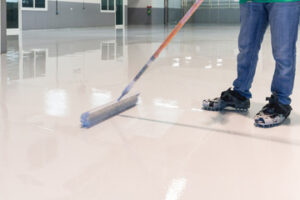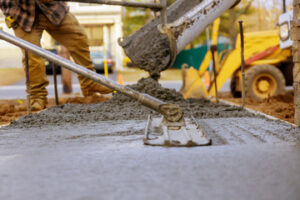Many epoxy floor coatings claim to be industrial or commercial grade, but you have to know what to look for. Read on to learn more about Epoxy Flooring WV coating option.

This flooring type is ideal for sports venues, commercial showrooms, and residential garages. The high-gloss sheen of this flooring can also brighten up facilities and make them more appealing to visitors.
Epoxy floors are highly flexible and can be used in a variety of applications. They are also suitable for renovations that do not require the use of heavy machinery, which cuts down on costs. The installation process is quick, too, and there are no harmful fumes. This means that the floor can be ready for use in just 24 hours, making it an ideal choice for businesses with tight deadlines.
Compared to other types of flooring, epoxy is very durable and can withstand a great deal of pressure. It is also resistant to sudden impact, high temperatures, and slippage. This makes it an excellent option for warehouses, commercial space, and industrial buildings. It is also a great solution for large spaces that need to be divided into different zones. For example, it can be applied to stairs to create a seamless effect and promote safety in the workplace.
In addition to being durable and long-lasting, epoxy floors are easy to maintain. Most of the time, a simple cleaning with a damp cloth and mild detergent is all that’s needed. These floors are also hygienic, as they don’t allow for the growth of bacteria and mold.
Moreover, epoxy floors are versatile and can be customized to meet the needs of each business or individual customer. They can be painted to match the design of a company’s logo or to reflect the style of an interior decor. They can even include a non-slip texture for greater safety. This type of floor can be installed on a wide range of surfaces, including concrete and wood.
Another benefit of epoxy floors is that they are highly resistant to rust and corrosion. This is particularly useful in areas where there are chemicals or heavy equipment. The coating is also able to withstand certain levels of heat, which makes it ideal for garages and workshops.
It is important to keep in mind that epoxy floors need to be properly maintained to ensure their durability and longevity. They should be swept regularly to remove dust, dirt, and debris. It is also recommended that they be vacuumed or hosed down once a month to prevent them from becoming slippery. It is also a good idea to put down protective mats in high-traffic areas, as these can help to protect the floor from damage caused by heavy equipment or furniture.
Durability
If you need a floor that can take on serious abuse, epoxy is the way to go. This flooring can resist abrasions, impact damage, and chemical spills. It can also be resurfaced over time to restore its original beauty. It’s important to test your concrete surface for any existing layers of paint or coating before installing epoxy, as they will prevent the bond from adhering properly.
In addition to durability, epoxy floors offer a wide variety of colors and textures that can be tailored to fit your space. They can be used for a range of applications, from residential to commercial and even industrial. They’re also an ideal choice for basements and garages. Here’s a look at how an epoxy coating can change the aesthetic of a church’s all-purpose room.
This type of flooring is not only durable, but it can also create a visual effect that’s unique from traditional paint. For example, you can use metallic pigments to add a shimmering texture and depth to your floors. This is a great option for any home or commercial project, and it can make your floors stand out from the rest of the building.
Epoxy floors are easy to clean and maintain, but there are some tips you should follow to keep them in great shape. First, you should try to keep your floors as dirt and grit free as possible. This is especially important when it comes to commercial and industrial floors, where vehicles and machinery are constantly moving on and off the floor. A good rule of thumb is to scrub your floors every week or two using a soft-bristled scrub brush and warm water.
Once you’ve made sure your floors are clean and dry, you should pay special attention to areas that receive heavy foot or vehicle traffic. It’s a good idea to place plywood or mats over your floors for extra protection, especially when working with welding equipment or large furniture pieces. This will help to prevent your floors from becoming scratched and damaged, and it’s also a good idea to put down plastic garbage bags if you’re going to be moving items that could puncture the surface of the floor.
Low Maintenance
The low maintenance of an epoxy floor is a big reason why it’s become so popular in homes. It can withstand the foot traffic of kids playing games, messy craft projects and household cleanups. It also withstands the weight of vehicles and tools without damage.
However, even though it’s so durable, the floor coating must be properly maintained to ensure its longevity. Keeping up with a regular cleaning and maintenance program minimizes scratching from abrasive dust and limits soilage buildup, which will prolong the floor’s life and improve its appearance.
Sweeping or vacuuming 3D epoxy flooring on a regular basis is essential to keep dirt and debris from accumulating and causing scratches. For larger stains, a mopping solution of equal parts water and clear ammonia can be used. Make sure to wring the mop out well to prevent excessive moisture that may damage the floor coating. Harsh chemical cleaners or acidic cleansers should never be used on an epoxy floor, as they can cause discoloration and cracking of the epoxy surface.
It is important to avoid sliding or dropping heavy equipment, pallets, sharp objects and other items on the epoxy floor, as this can result in deep cuts or gouges that can compromise the integrity of the flooring. If large areas of the floor are scratched or damaged, it is best to repair them immediately.
For areas of the garage or shop that are particularly busy with heavy traffic, it is a good idea to place felt protectors under furniture and machinery to prevent any indentations from being left behind on the floor coating. It’s also a good idea to lift heavy furniture or equipment instead of sliding it across the floor. Placing plywood or boards underneath heavy equipment can help to distribute the weight evenly and prevent concentrated pressure points on the epoxy floor, which could cause it to crack or become damaged. Lastly, using an exhaust system to control the air temperature in your garage or shop will also help to protect the epoxy floor, as extreme temperatures can affect its performance and appearance.
Aesthetics
While epoxy floors are primarily known for their durability and functionality, they are also visually stunning. They come in a wide array of colors, designs, and textures, and can be customized to suit the needs of your space. For example, you can add flakes to the epoxy coating to create a speckled or terrazzo-like look. You can even choose metallic epoxy to achieve an iridescent effect.
In addition to its aesthetic benefits, epoxy floor coatings are easy to clean and can withstand the use of harsh chemicals. This makes them a good choice for warehouses and industrial facilities, where spillages are common. For example, an epoxy coating can resist the effects of fruit juices and lactic acid, making it ideal for food companies and kitchens. It is also a good option for hospitals and pharmaceutical laboratories because it is highly hygienic.
For homeowners, epoxy flooring is a great option for garages and living areas. Its glossy finish reflects light, creating a bright and well-lit space. It is also a safe choice for residential spaces, as it increases visibility and decreases the risk of injuries due to slippery surfaces. In addition, epoxy floors are easy to wipe down with soap and water. However, they may require a longer period of full curing than other floor types.
Professionally installed epoxy floors can increase the value of your home or business, which is important if you plan to sell the property in the future. They are also easier to maintain than tile or wood floors. Moreover, they can last much longer than traditional concrete surfaces. Besides, they are resistant to scratching and chipping, and can withstand the force of vehicle tires.
While epoxy is primarily used for commercial and industrial spaces, it is now being used in many homes for flooring purposes. Its versatility and visual appeal have made it a popular choice for flooring in garages, kitchens, and laundry rooms. Additionally, it can be used in retail stores and offices to create a sophisticated and modern design.


